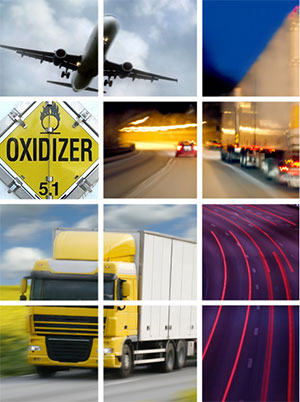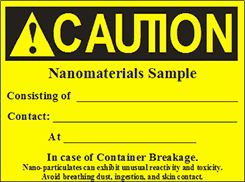- Home
- Facilities
- Research
-
Working at CFN
- Arrival & Departure
- Reports & Publications
- Acknowledging Use of CFN Facilities
- Data Management
- The Guide to Brookhaven
Safety Procedures
- Operations Plan
- Experimental Safety Reviews (ESR)
- COSA Training
- Hours of Operation
- Laser System Qualification
- Transport of Hazardous Materials
- Vendor On-site Scheduling Procedure (PDF)
- News & Events
- People
- Jobs
- Contact
- Business
- Intranet
Transportation of Hazardous Materials and Nanomaterials
The following contains guidance for transporting materials to and from BNL and for on-site transfers. All staff and users must adhere to Laboratory guidelines when making plans to move materials either by commercial carrier or in rented or personal vehicles.
BNL hazardous material transport guidelines apply for products that meet the definition of hazardous materials according to 49 CFR 171.8 and any nanomaterial that has known hazardous properties (toxic, flammable, reactive). BNL guidelines are also provided for all other nanomaterials even if they have not been identified as hazardous materials.
Some materials may be transported in personal vehicles as per “Materials of Trade” (MOT) guidance. The regulations for transporting MOT are much less restrictive and are based on a quantity limit for specific Department of Transportation hazard classes.
Transport of hazardous materials in personal vehicles at BNL must comply with the rules for Materials of Trade, and be on the BNL Materials of Trade table, or have prior approval of the Transportation Safety Officer. However, due to building hazard zone restrictions, CFN reserves the right to limit the acceptance of some quantities of chemicals. See the section on MOT transportation (below) for details.
Unsure if materials are considered hazardous? Ask the CFN safety staff:
-

James Buddenhagen
(631) 344-2422, jbuddenhagen@bnl.gov
-

Wailin Ng
(631) 344-7153, wailin@bnl.gov

Hazardous Material Transportation
From BNL to Off-site
- If the chemical container is bar coded with a Chemical Management System (CMS) label, remove the label, (even if you plan to return the material to BNL at a later date), place it on a Chemical Management System Bar-Code Label Removal Sheet, circle SARA Environmental Code # 2-Sent off-site, and send the form to the CMS Team, building 120.
- All shipping must be done through the Operational Support
and Planning (PL) Division, Building 98 (NOT
the Upton Post Office). Contact the CFN User
Administration Office, x 6266, and provide the following
information:
Shipping address, including street number, receiver's name, and telephone number, if available;
Quantity per container, container description, and count;
Exact chemical composition for reagent, solution, or mixture;
Chemical form, (e.g., gas, solid, or liquid).
Preferred transportation mode, (e.g., air or ground charge code) and Safety Data Sheet (SDS).
Your name and contact information. - Notify PL in advance to coordinate shipment and prepare for off-site transportation.
- If the material to be shipped was created at BNL, and no SDS exists for it, contact the Chemical Management System for assistance in developing an SDS. The Operational Support and Planning Division will not pick up material that does not have an SDS or approval from the Transportation Safety Officer.
- Contact PL, Building 98, at 344-2311 for pick-up and delivery to Brookhaven's shipping facility. To prepare the material for pick up, package it in the original manufacturer's container (or equivalent), make sure that the material is secured and labeled, a copy of the SDS is attached, and the shipping memo, as prepared by the User Administration Office, is tacked onto the outer box.
From Off-site to BNL
- Arrange to have the hazardous materials packaged and shipped through your shipping department, or obtain the services of a qualified broker, which will package and ship the hazardous materials to BNL in compliance with all Department of Transportation (DOT) and other applicable regulations.
- The name of the Facility Contact should be listed as the receiver so that your package can arrive before you and someone will be available to receive it.
- You must call or email the Facility Contact and inform him/her that your package is coming so arrangements can be made to pick up and properly store your materials.
- Packages should be addressed to:
Brookhaven National Laboratory
Building 98, Central Receiving
Attn: [Facility Contact Name], Bldg. 735
Upton, NY 11973-5000 USA
On-site (between buildings at BNL)
If your materials do not meet the definition of Materials of Trade (discussed below) the transport must be evaluated through use of the BNL On-site Transfer/Safety Assessment Form.
Complete the form and forward it to Cassandra Asselta (casselta@bnl.gov) for evaluation.
Transporting Nanomaterials
Packaging Requirements
The inner package must be labeled as follows:

Download the label and print on Avery Label #5264.
- Inner containers must be tightly sealed, rigid, and leak proof. Use tape on the cap to prevent the container from being unintentionally opened.
- Place the inner container in a ≥ 6 mil plastic bag.
- The outer package (sealed cardboard box OR sealed plastic container) must be filled with absorbent materials to protect the inner container and absorb liquids in the event of an inner container failure.
Nanomaterials To and From BNL
There are two classes of Nanomaterials with different transportation handling requirements:
Nanomaterials products that meet the definition of hazardous materials according to 49 CFR 171.8, and other nanomaterials that have been identified as having hazardous effects, (even if not listed in 49 CFR 171.8) must be packaged and labeled as indicated in the “Transportation of Nanomaterials” section above and be transported using the same criteria outlined in “Hazardous Material Transportation (between BNL and other institutions)”.
For Nanomaterials not identified to be hazardous:
- Package the nanomaterials as indicated in the “Transportation of Nanomaterials” section above.
- Prepare a document that describes the nanomaterials known properties and include that and SDS, if available, in the package.
- Notify the receiving organization to expect shipment.
- Shipment can be made by the most expeditious method
that complies with federal, state, and local law.
Nanomaterials On-site (between buildings at BNL)
Small quantities of nanomaterials that qualify as Materials Of Trade, and are not identified as known to be hazardous, may be carried in private vehicles when properly labeled and packaged. Large quantities must be evaluated using the BNL On-site Transfer/Safety Assessment Form, as described in “Hazardous Material Transportation”.
Materials of Trade
Materials of Trade transported on-site and off-site by personal vehicle
Materials of Trade (MOT) are hazardous materials, other than hazardous wastes, that are transported in small quantities and carried on a motor vehicle by a private individual in direct support of that persons business.
The rules for transport of MOTs are less restrictive than those for commercial transport because of their lesser hazard. You need not have shipping papers, emergency response information, placards, formal training, or record keeping. You do need, good packaging and labeling, some knowledge of this MOT exclusion (exclusion from the DOT rules for other materials), and you must meet the quantity limitations assigned to the material you are transporting.
Hazardous materials transported as MOTs must meet the following requirements:
- You must meet the quantity limitations listed below. If your material is not listed, ask someone on the CFN safety staff to help you.
- Your containers must be sealed, leak tight, and labeled with the common name of the material on the container.
- Containers must be placed in boxes that are securely closed, secured against movement, and protected against damage.
- Do not mix chemically incompatible materials within the same box.
- Have an SDS for each hazardous material in transport.
- Read and possess the DOT Brochure; “What Are Materials Of Trade, And What Regulations Apply?”
There is no MOT exclusion for:
- Radioactive materials.
- Compressed gasses.
- The Alkali metals; Sodium, Lithium, Potassium, Rubidium, and Cesium.
- These materials must not be transported in personal vehicles
There is no MOT exclusion for commercial aircraft. Hazardous and radioactive materials must not be transported on commercial aircraft.
MOT Quantity Limitations
Always limit the amount of material that you bring to the CFN to that quantity needed for your experiment. If you purchase reagents in liter or larger quantities at your home institution, transfer the few milliliters that you need in another container, seal and label that container, and bring that to CFN. Please do not bring more than you need, it complicates transport, adds to risks and stresses our limited storage capability.
The following common reagents must be limited to less than or equal to 500 ml:
- Solvents: Alcohols, Hexane, Acetone, Toluene.
- Acids: Hydrochloric, Sulfuric, Acetic, Nitric.
- Alkalines: Sodium or Potassium Hydroxide solutions, Ammonium Hydroxide
- Other: Hydrogen Peroxide (= 30%).
The following cannot, in any quantity, be brought into the CFN without pre-approval of the CFN ES&H Coordinator:
- Acids: Hydrofluoric
- Solvents: Chloroform, Benzene.
Researchers are urged to contact the CFN Facility Leader where the work is planned, because many of the standard chemicals and materials are already available.
Chemical Management System Bar Codes
The BNL Chemical Management System is used to track the quantities and locations of chemicals on site. Any chemicals purchased through the BNL Operational Support and Planning (PL) Division will arrive at CFN already entered into the CMS and with bar codes on the containers. Any chemicals that you bring to CFN that will remain in storage here after you depart, must also be bar coded and entered into the CMS. Materials that you bring, that will be on site for a few days, and that will be depleted or leave when you depart, need not be bar coded and entered into the CMS. You must provide an SDS to keep associated with a non-CMS coded chemical while it remains in the CFN facility.
If you need to have your containers bar coded and entered to the CMS or if your container has a bar code on it and you empty it, move it between buildings, or remove it from site, you must update the system to keep the inventory current. You can enter new materials, transfer existing materials, or delete a material from the database on the Chemical Management System website.
When you go to this page click on, CMS Web Forms. There you will find instructions on how to proceed. It will take two or three days to receive a new bar code sticker by BNL interoffice mail. If you need your bar code sticker sooner, contact the CMS group at x 2028 and they will come over with the sticker right away.
Trucks
Users who bring trucks on site must assure that the vehicle is not overweight and that the load is well balanced and secure. Operational Support and Planning (PL) division requires at least 4 hours' notice to schedule a delivery. PL's Receiving is available from 8 a.m. to noon and from 1 to 4 p.m., Monday - Friday. A truck scale is available and arrangements must be made to have your truck weighed and inspected before departing from the site by calling (631) 344-2311. Truck shipments must be accompanied by a completed BNL Shipping memorandum and it is your responsibility to assure that your truck is properly loaded. If your materials do not meet the MOT requirements, they do not belong on the truck and must be shipped through a commercial carrier.
If your materials do not meet the MOT requirements, they do not belong on the truck and must be shipped through a commercial carrier.




